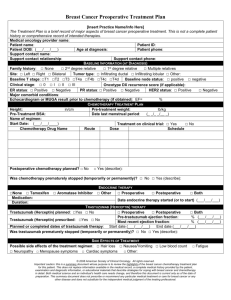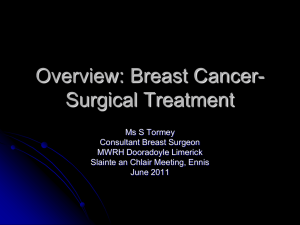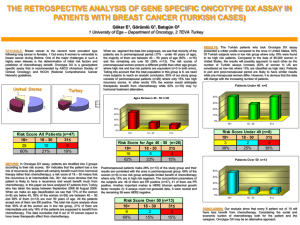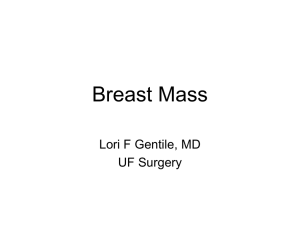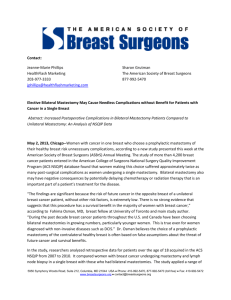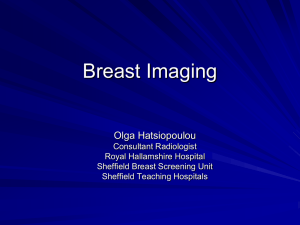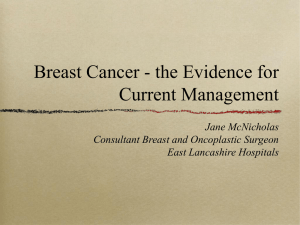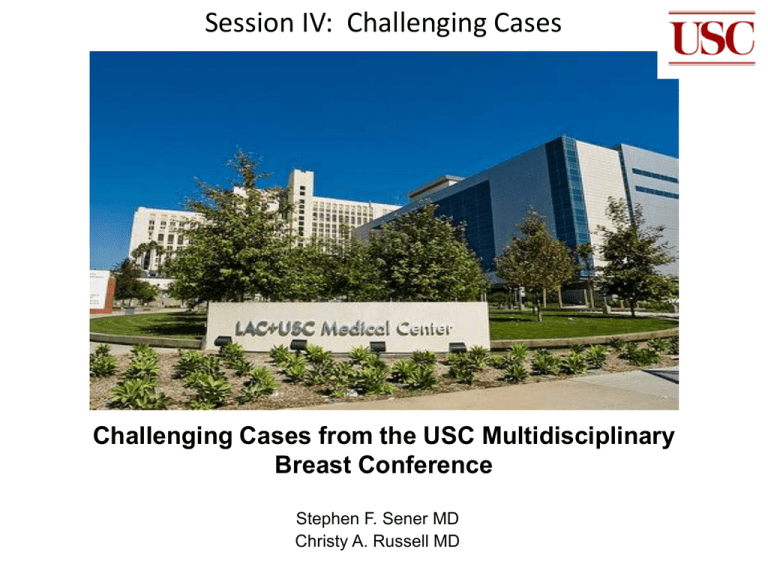
Session IV: Challenging Cases
Challenging Cases from the USC Multidisciplinary
Breast Conference
Stephen F. Sener MD
Christy A. Russell MD
CH
• Pregnancy and breast cancer.
• BRCA 1 positive phenotype.
CH
• 34 y.o. pregnant female (26 wks) self-discovered left
breast mass in the axillary tail.
• Mother with premenopausal breast cancer. Patient’s
mother is BRCA 1 & 2-negative. No information
regarding father’s medical history.
CH
CH
• Radiologic work-up: cT1N1(?) cancer.
– Mammogram - mass
– Ultrasound - 2.0 cm hypoechoic mass plus an
indeterminate adjacent lymph node.
• Core biopsy of primary tumor revealed infiltrating duct
cancer ER-PR-Her2-. Node not biopsied.
26 Week Gestation, Triple-negative
breast cancer
• What studies would you perform next?
1. MRI of the breasts
2. CXR and liver ultrasound
3. BRCA testing and results prior to any further
therapy
4. None of the above
26 Week Gestation, Triple-negative
breast cancer
Presuming she does not have metastatic cancer,
would you offer neo-adjuvant therapy first or
take the patient to surgery?
1. Neo-adjuvant chemotherapy with AC until
delivery
2. Segmental mastectomy, sentinel node biopsy,
possible axillary dissection and delay
chemotherapy until delivery
CH
• The patient chooses immediate surgery as she does
not want the fetus exposed to any potential harm
from chemotherapy.
• Margin-negative left lumpectomy and ALND,
performed at 28 weeks gestation. pT1c
N1(2/12+nodes).
• Genetic analysis performed after surgery revealed
BRCA-1 deleterious mutation.
• Her sister was subsequently tested positive for the
same BRCA-1 mutation.
• Patient’s labor was induced at week 35.
CH
• Chemotherapy with dose-dense doxorubicin,
cyclophosphamide followed by paclitaxel, started two
weeks postpartum.
• Bilateral mastectomy, done after completion of
chemotherapy, failed to reveal other primary breast
cancers.
• TAH-BSO is imminent.
CH Discussion
• The “BRCA-1” phenotype.
• Therapeutic decision making in pregnant patient.
– Radiographic workup-mammogram (yes), MRI (no).
– Timing during trimesters:
• Surgery first versus chemotherapy first.
– Choice of drugs.
– When to stop chemotherapy prior to delivery.
• Choice of operation.
– Sentinel node biopsy technique-Technetium 99 (yes), blue
dye (no).
– Timing of genetic consultation.
• Risk of new primary breast cancer.
• Timing of bilateral mastectomy and oophorectomy if BRCApositive.
Challenging Cases from the USC Multidisciplinary
Breast Conference
Stephen F. Sener MD
Christy A. Russell MD
BP
• 40 y.o. female with a self-discovered lump in
the left breast.
• Subpectoral implants for 5 years.
BP
BP
BP
BP
• Ultrasound-guided core biopsy revealed infiltrating
lobular carcinoma, ER+ PR+ Her2-.
• Patient underwent unilateral skin-sparing, nipple-sparing
total mastectomy and sentinel lymph node biopsy,
leaving the implant in place and maintaining the original
shape and size of the breast.
– pT1c (2.0cm) N0, Stage I.
40 year-old with T1C,NO, ER+ breast
cancer
• Would you order Oncotype Dx for this 40 yearold patient?
1. Yes
2. No
40 Year-old T1c, N0, ER+
• If you order a Recurrence score through
Oncotype Dx, what is the range of RS that you
would strongly recommend chemotherapy be
added to hormonal therapy?
1.
2.
3.
4.
Anything over 15
Anything over 18
Anything over 25
Anything over 31
40 Year-old T1c, N0, ER+
• I performed Oncotype Dx
• Recurence score was 11
• Tamoxifen was offered, chemotherapy
discouraged.
Challenging Cases from the USC Multidisciplinary
Breast Conference
Stephen F. Sener MD
Christy A. Russell MD
CM
• 65 y.o. female with a family history of breast cancer in
postmenopausal sister and 4 paternal aunts. Prior TAHBSO.
• Self-discovered lump in the right breast.
– Mammogram –6 cm area of subtle calcifications.
– Ultrasound – irregular 2.5 cm (palpable) mass.
– MRI – 2.5 cm right breast mass, corresponding to
palpable mass.
CM
CM
CM
CM
CM
• Ultrasound-guided core biopsy-infiltrating
duct cancer ER+PR+Her2-.
• Stereotactic biopsy of calcifications-DCIS.
CM
• Because of the extent of calcifications, and +
biopsy for DCIS, mastectomy is recommended.
• The patient requests contralateral
prophylactic mastectomy.
• The patient undergoes right total mastectomy
with SLN biopsy and contralateral prophylactic
mastectomy.
• Pathologic staging: pT2 (5.0 cm), N0, M0
CM
• Would you perform Oncotype Dx on this 65year old woman with a 5.0 cm malignancy?
1. Yes
2. No
CM
• Her Oncotype Dx recurrence score is 8.
• Presuming you offer her an aromatase
inhibitor, what is her long-term risk of a
contralateral primary malignancy?
1.
2.
3.
4.
0-5%
6-10%
11-15%
16-20%
TRENDS IN THE PROPORTION OF MASTECTOMY PATIENTS
WHO HAD CONTRALATERAL PROPHYLACTIC
MASTECTOMY BY STAGE
Tuttle et al. J Clin Oncol 2007;25:5203-5209.
ANNUAL HAZARD RATES FOR CONTRALATERAL BREAST CANCER
(CBC) OVER TIME AND ACROSS AGE FROM 1975 TO 2005 AFTER A
FIRST BREAST CANCER (A,C).
Nichols H B et al. JCO 2011;29:1564-1569
©2011 by American Society of Clinical Oncology
CM
• Long-term risk of contralateral primary
malignancy is approximately 4%
End of Session IV
Challenging Cases from the USC Multidisciplinary
Breast Conference
Stephen F. Sener MD
Christy A. Russell MD


